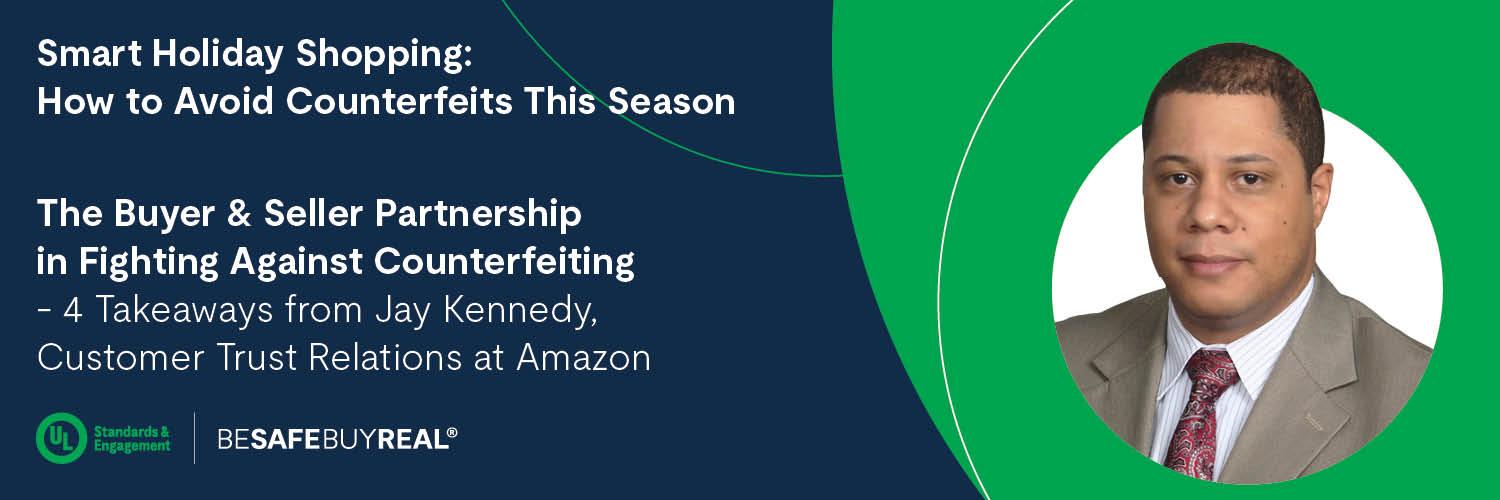The Buyer & Seller Partnership in Fighting Against Counterfeiting

The Buyer & Seller Partnership in Fighting Against Counterfeiting
— 4 Takeaways from Jay Kennedy, Amazon

Nearly 60% of consumers have trouble telling the difference between a real product and a fake product, especially when shopping online. With the rise of ecommerce — especially during the pandemic — it can be really difficult to find legitimate products while simultaneously searching for the best deal. With Black Friday and Cyber Monday just around the corner and holiday shopping kicking into full gear, consumers need to be educated on the realities of shopping online.
Jay Kennedy, who works in Customer Trust Relations at Amazon, recently joined our Facebook Live event — “Smart Holiday Shopping: How to Avoid Counterfeits This Season” — and provided insights into the dangers of counterfeit products and how consumers and companies can work together to combat them.
Following are his top 4 takeaways.
Counterfeits pose danger to consumers and society
There are two dangers of counterfeit products: dangers of the products themselves and where the money from your purchase is going.
Counterfeit products are made in places that don't have the same manufacturing standards as legitimate products. They don't go through the same quality assurance checks. They may not even have the same base ingredients as legitimate products. On the outside, it may look to be legitimate, but you don't know the inherent risks that are in those products. They may cause fires in some cases, as the UL Enterprise has documented. They can cause harm to consumers. In some cases, they may not harm us at all. But it's really a roll of the dice.
The other danger around counterfeit products is that you don't really know where that money is going. And in some cases, the money goes to an individual who is running a retail store and selling counterfeit products maybe alongside legitimate products. On the other end of the spectrum, we have seen instances where the funds from counterfeits go to support terrorist activities and transnational criminal activity.
Companies are investing in solutions
Consumers aren’t fighting counterfeiters alone. Amazon invests close to about $1 billion a year in our anti-counterfeiting, fraud and abuse activities to make sure their customers have a safe and trustworthy shopping experience. Amazon dedicates about 12,000 Amazon employees to try to stop these counterfeit activities. But ultimately, if you are shopping in our store and you do happen to get a counterfeit product, we will make it right for you every time.
Consumers can help solve the problem
Consumers have a lot of power in being able to protect themselves, but also to help make online spaces — like Amazon — a much safer place for everyone going forward. The first step is to arm consumers with knowledge. We take a long-term approach to combating counterfeiters by educating consumers, especially younger consumers, on how to keep themselves and their peers safe.
Be a conscious consumer
Consumers do have the power. Counterfeiting is the purest form of a mercenary crime, where it is driven purely by profits and for counterfeit goods. Nearly 60% of people can't tell the difference between a counterfeit and legitimate product. That’s why consumer education is so important. The only way we can make sure counterfeiters don’t win is by educating people on the environmental impacts, the human impacts and what buying a counterfeit could mean for their health and safety. An educated consumer is a conscious one.
